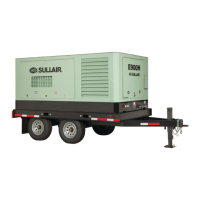2: Description E900H User Manual
02250203-986 R03
22 Subject to EAR, ECCN EAR99 and related export control restrictions.
valve in an open position. The inlet valve will remain in
the full load position as long as the compressor is running
at 150
psig (10.3 bar) or below.
Modulation—150 to 165 psig (10.3 to 11.4 bar)
As air demand drops below the rated capacity of the
compressor, the line pressure will rise above 150 psig
(1
0.3 bar). As the air pressure exceeds 150 psig
(1
0.3 bar), the differential press
ure regulator controlling
the inlet valve opens. This allows the air pressure into the
unload chamber of the inlet valve, which starts partially
closing the inlet valve, providing modulation. During this
period, the pressure rises approximately from 150 to
165 psig (10.3 to 11.4 bar).
Unload mode—in excess of 165 psig (11.4 bar)
When a relatively small amount or no air is being used,
the service line pressure continues to rise. When it
exceeds 165 psig (11.4 bar), the pressure switch ener-
gizes the solenoid, applying pressure to the unload
cha
mber of the inlet valve, which fully closes the valve.
Simultaneously, the solenoid valve sends a pneumatic
signal to the blowdown valve. The blowdown valve opens
the sump to the atmosphere. This reduces the sump
pressure to approximately 25 psig (1.7 bar), which results
in
low horsepower consumption. The check valve in the
air service line prevents line pressure from returning to
sump while the compressor is running in the unloaded
mode. The inlet valve remains in the unload position.
When the line pressure drops back to 150 psig (10.3 bar)
d
ue to an increase in the air demand, the pressure switch
de-energizes the solenoid valve removing air pressure
from the unload chamber, opening the inlet valve. The
blowdown valve closes, and the inlet valve opens.
2.8 Aftercooled air system,
functional description
Refer to Figure 2-3 and Figure 2-4. The purpose of the
aftercooled air system is to op
erate the air compressor in
conditions when compressed air temperatures are
required to be 10 to 25°F (5 to 13°C) over ambient tem-
perature. A 3-valve bypass is pr
ovided to switch between
standard and aftercooled air. The ambient air, which is
blown through the aftercooler by the motor-driven fan,
cools the compressed air as it passes through the after-
cooler core. Cooled air enters the moisture separator
whe
re condensation is removed from the cooler air and
discharged. This condensation does carry some oil and it
should be disposed of properly in accordance with local
regulations. A condensation drain port is located in the
frame on the front of the machine for convenience of con-
densate removal. This drain po
rt should never be
plugged or closed off in any way. From the moisture sep-
arator the compressed air goes through the discharge fil-
ters and on to the service valve.
NOTE
Aftercooled system should not be operated in
ambient conditions below 32°F (0°C).
To operate in the non-aftercooled mode, open
an
d close the appropriate valves.

